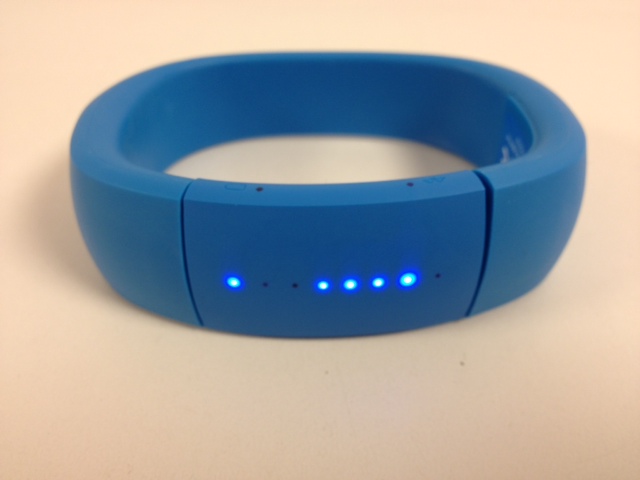This review is part of our series on the most popular fitness tracker devices. Read the full story here.

My first impression of the larklife -- especially compared to the sleek Nike FuelBand and the discreet FitBit -- is that it's clunky. But the band itself was comfortable for the most part, and the iPhone app was simple and easy to follow (almost to a fault -- some of the info, especially the food tracker, was extremely basic). At first, I felt compelled to explain to everyone why I was wearing this strange-looking device on my wrist, but, over time, it grew on me. My favorite part of the experience was, hands down, tracking my step count. I became a little obsessed with hitting 10,000 steps and found myself scheduling more walking meetings during the work day and running more errands at night, just to up my count. These small changes really add up, and make me more mindful of my sedentary days. The first day I didn't wear the band after the trial period, I found myself wondering how many steps I was taking -- I missed knowing.
One of the most unique attributes of the larklife, compared to other trackers, is its nighttime sleep tracker. At the end of each day, you slip on the nighttime wristband, which tracks how long it takes you to fall asleep, how many times you wake up throughout the night and the total number of hours slept. It also wakes you up in the morning with a silent vibration on your wrist.
The app sends you text-like messages when it notices you haven't been moving for a while -- I felt a bit like it was heckling me at my desk (are you going to get my work done, larklife?), but I can appreciate the value of a reminder to get up out of the chair and move around. And some of the other coaching tips on the app, like suggesting meal adjustments or pointing out when I've been awake for a long time, were surprisingly insightful.
As for the downsides? My least favorite part was probably the battery life -- I had to charge both wristbands at least every other day. And when I forgot to charge the nighttime band during the day, I couldn't get my sleep data (I figured my sleep tracker isn't worth losing sleep over). I also found the bluetooth syncing to be a bit glitchy -- sometimes I had trouble connecting the band and the phone, and couldn't figure out why. Then I'd try again later and it would work.
Wearability
The larklife is actually two wristbands -- one for day and one for night -- with an interchangeable center piece that you move from one to the other. The big blue band for daytime isn't exactly my idea of a stylish bracelet -- it's definitely bulkier than some of the others we tried out, and could stand to be slimmed down. I'd also like either a more discreet color, or, better yet, something decorative that looked like an actual bracelet. It was comfortable enough, though I found when I wore other bracelets on my hand, they'd accidentally hit the button on the side if I wasn't careful (telling the device I'm, say, going to sleep at 3:30 p.m. or eating 10-plus meals a day). I also found it fell off my wrist sometimes, especially when taking my coat on or off. I've tried the original Lark sleep tracker in the past -- the night band is similar to that and was easy enough to sleep in.
Usability
I needed to update my phone software (and, before that, my iTunes software) to get the whole thing set up -- I know that's my own fault, but it took some time. Once I downloaded the larklife app, it was pretty simple to sync it up with the wristband. The wristband and the phone connect using bluetooth, which drained my phone battery a bit. (And sometimes it wouldn't sync up and I couldn't figure out exactly what I was doing wrong.) I also wish the wristband displayed some info directly, like step count, as it's a little annoying to always have to open the app on my phone to see my progress. There are lights that indicate your activity level, but they didn't mean much to me.
Use
The most interesting info, for me, was my step count -- something a simple pedometer could calculate. I actually take more steps than I thought I did -- 5,000 to 6,000 on my most sedentary days, and I easily hit a respectable 10,000 with just a bit of extra activity. There's a meal tracker, but it's very basic -- you need to enter a meal when you eat it (I didn't see any way to go back and add one in later if you forgot), and put it into a general category bucket: protein, vegetable, fruit, grain or water. It doesn't provide any detailed nutrition information like some other trackers on the market, though I will say it made me a bit more mindful of how many times a day I eat. And the sleep information was interesting, if not that surprising (especially since I've already used a regular Lark wristband to track my sleep).
Effectiveness
Wearing the wristband and being able to check my step count any time definitely motivated me -- I wanted to break 10,000 every day, so if I was lagging, I might get off the train a few stops early and walk the rest of the way home after work. The system also sent me messages -- particularly if I had been sedentary for a long time. I found this to be mostly annoying (I could almost never move when it wanted me to), but some of the other advice was more helpful and surprising.
Price
$149.99. Sorry to say, but I think a cheaper pedometer would be less bulky and just as helpful.